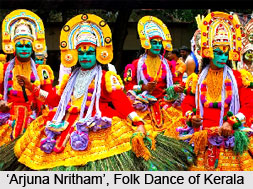 Arjuna Nritham is also known as `Mayilpeeli Thookkam` is a well known folk dance form of the state of Kerala. This dance in a form of ritual art is performed by men. The term ` Arjuna Nritham` means dance of Arjuna which is usually performed mostly in southern part of Kerala in the Bhagavathy temples, especially in the Kottayam, Kollam and Alapuzzha districts. According to Hindumythology Arjuna, the most valiant of five Pandavas pleased goddess Bhadrakali with the performance of this devotional form. This art form is presented by the performers, mainly the community of the `Ezho`, throughout the entire night.
Arjuna Nritham is also known as `Mayilpeeli Thookkam` is a well known folk dance form of the state of Kerala. This dance in a form of ritual art is performed by men. The term ` Arjuna Nritham` means dance of Arjuna which is usually performed mostly in southern part of Kerala in the Bhagavathy temples, especially in the Kottayam, Kollam and Alapuzzha districts. According to Hindumythology Arjuna, the most valiant of five Pandavas pleased goddess Bhadrakali with the performance of this devotional form. This art form is presented by the performers, mainly the community of the `Ezho`, throughout the entire night.
Origin of Arjuna Nritham
This dance form has been mentioned in the Hindu epic Mahabharata. Arjuna, the middle brother of the Pandavas is said to be the best warrior and most valiant. After the fierce battle at Kurukshetra among the Kauravas and Pandavas, was won Arjuna performed this devotional dance to gratify Goddess Kali.
Dance Style of Arjuna Nritham
This dance form is performed by males in pairs or as solo. `Nilavilakku`, traditional oil lamps are used to enlighten the atmosphere and to create the ambience. The songs of this dance form are called `Kavithangal` or `Mayil Pattukal`. It deals with Hindu mythological themes such as the Indian Puranas. The dance is a rigorously rhythm based one and hence each Kavitham is composed to a particular rhythm. `Ekatala`, `Roop Tala`, `Charpata Tala` and `Panchari Tala` are some of the `talas` used in Arjuna Nritham. The subtleties of rhythm, the beautification of postures, the gestures clearly narrates the subject matter and the story to the audience. The movements and dance style have similarities with the Kalarippayattu techniques.
Costumes of Arjuna Nritham
The costume worn during this performance is a kind of lower garment. The costume is made of peacock feathers for which Lord Krishna has a special penchant, thereby symbolizing one of the facets of the relationship between Krishna and Arjuna. This flashy coloured skirts are worn around the waists which resembles uduthukettu of Kathakali. The dancers paint their faces with green vegetable colours in a traditional way as part of the costume and also adorn headgears.
Instruments used during Arjuna Nritham
Percussion is the main instrument that is used during dance as it is a rhythm based dance form. The traditional instruments played along with this dance are `Chenda`, `maddalam`, `talachenda` and `ilathalam` or the cymbals.
Arjuna Nritham has a characteristic style of its own and this popular dance form is tried to be revived both by the state government and the native people of Kerala.



















